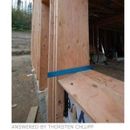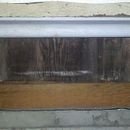Seal or Vent Bottom of Balloon-Framed Wall?
I am replacing the water table and belly band on my 1903 house that had the foundation replaced.
The wall constructions is studs, turned either short or long side out, and then board and baton style sheathing, and then lap siding. The board and baton form a sort of drainage plane behind the siding. However, there’s no building paper vapor or air barrier over the sheathing, and the boards seem like there are plenty of air leaks between them. The walls have cellulose insulation, and the siding is covered with asbestos cement shingles, which I hope to remove some day.
The dilemma is this:
Do I seal the bottom of the wall? The photos show the walls with new water table, but no belly band yet. As shown in the first picture, it originally had two horizontal 1″ boards across the bottom (with an unintended gap between the two boards in places), on top of which goes the belly band. So it was sort of sealed, but not tightly.
1) If I seal the bottom, any moisture that gets behind the siding may have trouble draining. It currently has that extra layer of asbestos shingles with building paper between the shingles and the original wood siding, but that may get removed in the future.
2) If I screen it, then there could be considerable air leakage through the wall (since there is no air barrier — I’ve caulked between the boards just at the bottom, where the gaps were large) reducing insulation effectiveness, as well as increasing moisture-laden air flow.
3) Or, do I compromise and drill weep holes across the bottom, thereby allowing some drainage and drying, but hopefully reducing wind blowing air through the wall.
Thanks!
GBA Detail Library
A collection of one thousand construction details organized by climate and house part











Replies
Adam,
I understand your dilemma. I would vote for air sealing the bottom of the wall.
Any water that gets past your siding should be able to dry to the exterior by diffusion, aided by the pumping action that accompanies changes in the outdoor temperature.
Thanks Martin, I'll do that.
Adam